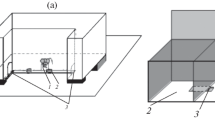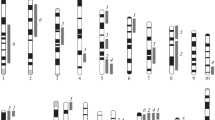Abstract
Using the selected mouse strain EX as the founding population (selection for extrapolation ability) three selection generations of mice were obtained, which were selected for successful solution of object permanence test (plus-sub-strain) and for lack of such solution (minus-sub-strain). The successful solution required not only the ability to operate the object permanence rule (by J. Piajet), but the performance of complicated action (executive function) which was significantly higher in plus-substrain, and this is the unique example of successful selection for cognitive trait.


Similar content being viewed by others
REFERENCES
Graybeal, C., Bachu, M., Mozhui, K., et al., Strains and stressors: an analysis of touchscreen learning in genetically diverse mouse strains, PLoS One., 2014, vol. 9, no. 2.
Saez, I., Set, E., and Hsu, M., From genes to behavior: placing cognitive models in the context of biological pathways, Front. Neurosci., 2014, vol. 8, p. 336.
Sauce, B. and Matzel, L.D., The paradox of intelligence: heritability and malleability coexist in hidden gene–environment interplay, Psychol. Bull., 2018, vol. 144, no. 1, pp. 26–47.
Bainbridge, N.K., Koselke, L.R., Jeon, J., et al., Learning and memory impairments in a congenic C57BL/6 strain of mice that lacks the M2 muscarinic acetylcholine receptor subtype, Behav. Brain Res., 2008, vol. 190, no. 1, pp. 50–58.
Too, L.K., Li, K.M., Suarna, C., et al., Deletion of TDO2, IDO-1 and IDO-2 differentially affects mouse behavior and cognitive function, Behav. Brain Res., 2016, vol. 312, pp. 102–117.
Nolan, S.O. and Lugo, J.N., Reversal learning paradigm reveals deficits in cognitive flexibility in the fmr1 knockout male mouse, F1000Res, 2018, vol. 7, p. 711.
Granseth, B., Andersson, F.K., and Lindstrom, S.H., The initial stage of reversal learning is impaired in mice hemizygous for the vesicular glutamate transporter (VGluT1), Genes Brain Behav., 2015, vol. 14, no. 6, pp. 477–485.
Manning, E.E., Dombrovski, A.Y., Torregros-sa, M.M., et al., Impaired instrumental reversal learning is associated with increased medial prefrontal cortex activity in Sapap3 knockout mouse model of compulsive behavior, Neuropsychopharmacology, 2019, vol. 44, no. 8, pp. 1494–1504.
Perepelkina, O.V., Lil’p, I.G., Markina, N.V., et al., The first experience of selection of laboratory mice for a high ability to extrapolate, in Formirovanie povedeniya zhivotnykh v norme i patologii: K 100-letiyu so dnya rozhdeniya L.V. Krushinskogo (1911–1984) (Formation of Animal Behavior in Health and Disease: to the 100th Anniversary of the Birth of L.V. Krushinsky (1911–1984)), Moscow: Yazyki Slavyanskikh Kul’tur, pp. 263–296.
Galsworthy, M.J., Paya-Cano, J.L., Liu, L., et al., Assessing reliability, heritability and general cognitive ability in a battery of cognitive tasks for laboratory mice, Behav. Genet., 2005, vol. 35, no. 5, pp. 675–692.
Perepelkina, O.V., Tarasova, A.Yu., Ogienko, N.A., et al., Brain weight and cognitive ability of a laboratory mouse; Usp. Sovrem. Biol., 2019, vol. 139, no. 5, pp. 434–445.
Yegla, B., Foster, T.C., and Kumar, A., Behavior model for assessing decline in executive function during aging and neurodegenerative diseases, Methods Mol. Biol., 2019, vol. 2011, pp. 441–449.
Ben Abdallah, N.M., Fuss, J., Trusel, M., et al., The puzzle box as a simple and efficient behavioral test for exploring impairments of general cognition and executive functions in mouse models of schizophrenia, Exp. Neurol., 2011, vol. 227, no. 1, pp. 42–52.
Giménez-Llort, L., Schiffmann, S.N., Shmidt, T., et al., Working memory deficits in transgenic rats overexpressing human adenosine A2A receptors in the brain, Neurobiol. Learn. Mem., 2007, vol. 87, no. 1, pp. 42–56.
Li, Q., Chan, S.Y., Wong, K.K., et al., Tspyl2 loss-of-function causes neurodevelopmental brain and behavior abnormalities in mice, Behav. Genet., 2016, vol. 46, no. 4, pp. 529–537.
Hunsaker, M.R., The importance of considering all attributes of memory in behavioral endophenotyping of mouse models of genetic disease, Behav. Neurosci., 2012, vol. 126, no. 3, pp. 371–380.
Locurto, C., Benoit, A., Crowley, C., et al., The structure of individual differences in batteries of rapid acquisition tasks in mice, J. Comp. Psychol., 2006, vol. 120, no. 4, pp. 378–388.
Ene, H.M., Kara, N.Z., Barak, N., et al., Effects of repeated asenapine in a battery of tests for anxiety-like behaviours in mice, Acta Neuropsychiatr., 2016, vol. 28, no. 2, pp. 85–91.
Author information
Authors and Affiliations
Corresponding author
Ethics declarations
COMPLIANCE WITH ETHICAL STANDARDS
Conflict of interest. The authors declare that they have no conflict of interest.
Statement on the welfare of animals. The experimental protocol was accepted by the Bioethical Commission of Moscow State University, session no. 49 of June 18, 2014.
FUNDNING
The research was carried out under the state assignment of Ministry of Science and Higher Education of the Russian Federation (theme no. 121032500080-8) and supported by the Russian Foundation for Basic Research (project no. 20-015-00287) and the state program no. ААА-А16-116021660055-1.
Rights and permissions
About this article
Cite this article
Perepelkina, O.V., Poletaeva, I.I. Selection of Laboratory Mice for the Cognitive Task Successful Solution and for the Inability to Solve It. Dokl Biochem Biophys 499, 207–210 (2021). https://doi.org/10.1134/S1607672921040116
Received:
Revised:
Accepted:
Published:
Issue Date:
DOI: https://doi.org/10.1134/S1607672921040116




